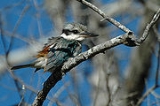
Red-backed Kingfisher
Encyclopedia
The Red-backed Kingfisher (Todiramphus pyrrhopygius) is a species of kingfisher
in the Halcyonidae
family, also known as tree kingfisher
s. It is a predominantly blue-green and white bird with a chestnut rump. It is found across the continent of Australia, mainly inhabiting the drier regions.
in 1841. It was known for many years by its old scientific name of Halcyon pyrrhopygia before being transferred to the genus Todiramphus
. Its specific epithet is derived from the Ancient Greek
words pyrrho-/πυρρο- "flame-coloured" or "red" and pyge/πυγή "rump".
. It is a summer visitor to the southeast of the country; elsewhere it is resident all year round. It inhabits
dry forest
s, mulga
and mallee
country, to savannah. It avoids denser forests. During breeding season, birds will move to river courses to make use of the earthy banks to dig nesting burrows.
Kingfisher
Kingfishers are a group of small to medium sized brightly coloured birds in the order Coraciiformes. They have a cosmopolitan distribution, with most species being found in the Old World and Australia...
in the Halcyonidae
Tree kingfisher
The tree kingfishers or wood kingfishers, family Halcyonidae, are the most numerous of the three families of birds in the kingfisher group, with between 56 and 61 species in around 12 genera, including several species of kookaburras. The family appears to have arisen in Indochina and the Maritime...
family, also known as tree kingfisher
Tree kingfisher
The tree kingfishers or wood kingfishers, family Halcyonidae, are the most numerous of the three families of birds in the kingfisher group, with between 56 and 61 species in around 12 genera, including several species of kookaburras. The family appears to have arisen in Indochina and the Maritime...
s. It is a predominantly blue-green and white bird with a chestnut rump. It is found across the continent of Australia, mainly inhabiting the drier regions.
Taxonomy
The Red-backed Kingfisher was first described by the ornithologist John GouldJohn Gould
John Gould was an English ornithologist and bird artist. The Gould League in Australia was named after him. His identification of the birds now nicknamed "Darwin's finches" played a role in the inception of Darwin's theory of evolution by natural selection...
in 1841. It was known for many years by its old scientific name of Halcyon pyrrhopygia before being transferred to the genus Todiramphus
Todiramphus
Todiramphus is a genus of kingfishers in the family Halcyonidae. The name is often spelt Todirhamphus but Todiramphus is the original valid spelling. There are around 20-22 extant species in the genus but the classification of several Pacific island forms is still unclear...
. Its specific epithet is derived from the Ancient Greek
Ancient Greek
Ancient Greek is the stage of the Greek language in the periods spanning the times c. 9th–6th centuries BC, , c. 5th–4th centuries BC , and the c. 3rd century BC – 6th century AD of ancient Greece and the ancient world; being predated in the 2nd millennium BC by Mycenaean Greek...
words pyrrho-/πυρρο- "flame-coloured" or "red" and pyge/πυγή "rump".
Description
Measuring 20–22.5 cm (9 in), the Red-backed Kingfisher has a streaked green and white crown, bluish-green wings and tail, and lower back, rump and upper tail coverts chestnut with white breast, abdomen and nape. It has a black band stretching from the bill, through the eyes and to the ear coverts. The female is duller overall in coloration. The iris is dark brown and the legs and feet dark grey. Immature birds have speckling on their breasts. The call is a descending whistle, with a harsh alarm call given by birds near the nest.Distribution and habitat
The Red-backed Kingfisher is native to most of AustraliaAustralia
Australia , officially the Commonwealth of Australia, is a country in the Southern Hemisphere comprising the mainland of the Australian continent, the island of Tasmania, and numerous smaller islands in the Indian and Pacific Oceans. It is the world's sixth-largest country by total area...
. It is a summer visitor to the southeast of the country; elsewhere it is resident all year round. It inhabits
Habitat
* Habitat , a place where a species lives and grows*Human habitat, a place where humans live, work or play** Space habitat, a space station intended as a permanent settlement...
dry forest
Forest
A forest, also referred to as a wood or the woods, is an area with a high density of trees. As with cities, depending where you are in the world, what is considered a forest may vary significantly in size and have various classification according to how and what of the forest is composed...
s, mulga
Mulga
Acacia aneura, commonly known as Mulga or True Mulga, is a shrub or small tree native to arid outback Australia of areas such as the Western Australian Mulga shrublands.-Description:...
and mallee
Mallee Woodlands and Shrublands
Mallee Woodlands and Shrublands is a Major Vegetation Group which occurs in semi-arid areas of southern Australia. The vegetation is dominated by mallee eucalypts which are rarely over 6 metres high...
country, to savannah. It avoids denser forests. During breeding season, birds will move to river courses to make use of the earthy banks to dig nesting burrows.

